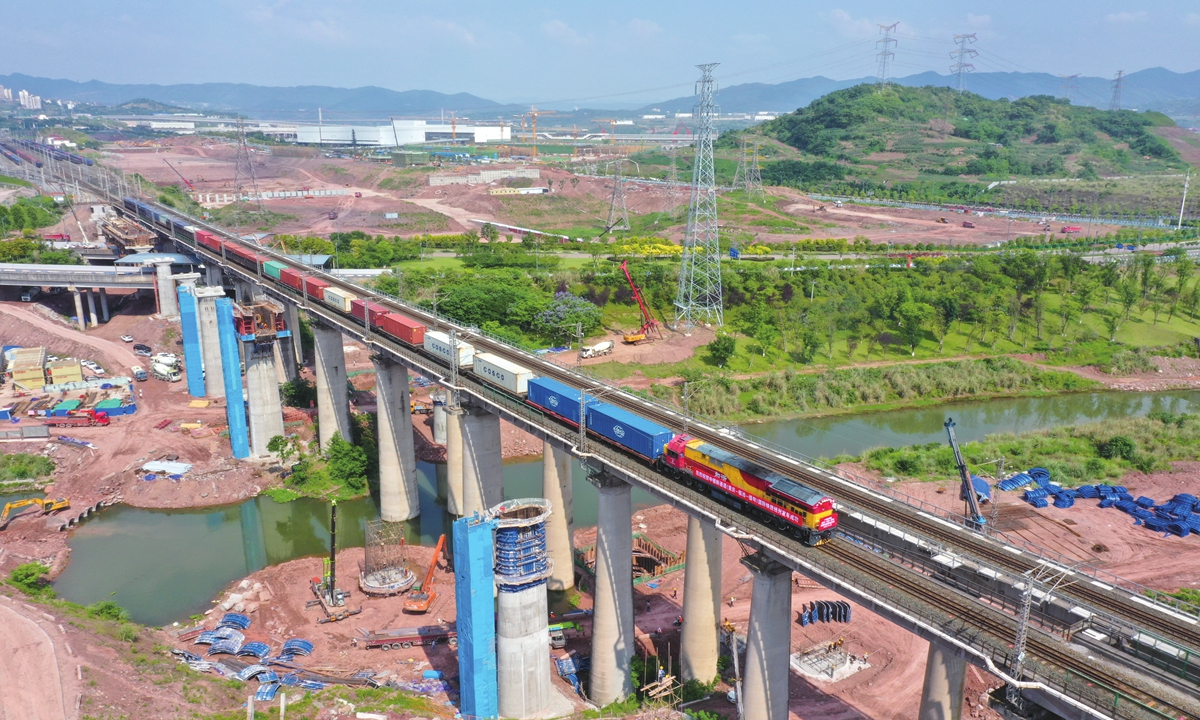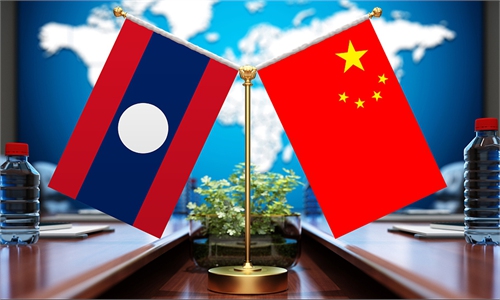RCEP heralds ASEAN agricultural trade boom with bright prospects
Deeper cooperation built on RCEP, with more to come

The first freight train along the new international rail link from Southwest China's Chongqing Municipality to Mandalay, southern Myanmar, departs on May 23, 2022. Photo: Xinhua
"Frozen Thai durians are my all time favorite fruit for the summer along with deserts such as crepe cakes made with durian," a Beijing-based white-collar worker surnamed Wang told the Global Times on Tuesday.
The Global Times learned that the monthly sales of Thai durians on e-commerce platforms such as Taobao have already surpassed 10,000 orders as of press time.
Thai durian is popular among many Chinese consumers, accounting for 90 percent of China's total imported durians, Zhu Danpeng, a veteran food industry observer, noted.
The hot sale of Thai durians is just an epitome of the booming trade between China and the Association of Southeast Asian Nations (ASEAN), which have seen a frog leap following the surging demand for a wide range of agricultural products from the Chinese market. Momentum has been further boosted with the implementation of the Regional Comprehensive Economic Partnership (RCEP), which took effect at the beginning of 2022.
Strengthened cooperation
China has been ramping up efforts to promote the import of agricultural products from ASEAN on the back of multiple supportive measures and policies targeting logistics, customs clearance and other aspects along the value chain.
For example, Chinese authorities have relaxed the inspections for vehicles transporting fruits from Wanding Port in South China's Yunnan Province, which borders Myanmar, industry website chinafruitportal.com reported on Tuesday.
In addition to easing the inspections of fruit transport vehicles, China has also made a number of adjustments to its epidemic prevention and control measures, such as reducing the required documents for vehicles entering China from four to two. The easing of restrictions has contributed to the recovery of cross-border trade between Myanmar and China, and significantly boosted the export of Myanmar mangoes, the report noted.
Qualified fresh longans from Cambodia are able to be directly exported to China starting from May 19, the General Administration of Customs (GAC) said. Cambodia could generate an additional $200 million of income through these exports which can now bypass Thailand on their way to the Chinese market, according to media reports.
ASEAN remained China's largest trade partner for the first four months this year with total trade reaching $289.27 billion, up 9.4 percent compared with 2021, official data from GAC showed.
Agricultural products from ASEAN are already popular in China due to the short distance they have to travel, while the number of unique fruits and vegetables and shared regional supply chains also represent a key advantage, Zhu told the Global Times on Tuesday.
Zhu added that the implementation of RCEP has further benefited agricultural trade with the domestic consumption levels continuing to rise, leading to a surge in demand for products such durian, banana, jackfruit, papaya and other products.
China also contributes indispensably to ensure smooth and effective logistics for product delivery from ASEAN markets, reflected by the nation's efforts in opening up special flight routes and infrastructure construction.
China and ASEAN members are bolstering logistics connectivity after the China-Laos Railway, a major project under the China-proposed Belt and Road Initiative was launched in December, making it possible for Thai fruits to be delivered to China via road-rail link. The first Durian Express reached the southern Chinese city of Guangzhou in April, the Xinhua News Agency reported in May.
The China-Laos railway will make the distribution of Thai durians more flexible and diverse, allowing Thai fruit exporters to deliver quality products to China, the Thai Durian Association told the Global Times in an earlier interview, adding that the transport route can also better comply with the zero COVID-19 policy and reduce contamination with only one driver.
The association noted that Thai durians are still seeing increasing demand from Chinese consumers, and quality control from both public and private sectors in Thailand is increasing every year to ensure the safety and quality of the fruit delivered to China.
Bright prospects
The trade volume between China and ASEAN members has been growing strongly over recent years, a cross border fruit trader in Pingxiang, Guangxi Zhuang Autonomous Region, one of China's major fruit ports, told the Global Times on Tuesday.
China set the goal at the end of 2021 to import a total of $150 billion worth of agricultural products from ASEAN over the upcoming five years.
Moving forward, Zhu expected that the trade in agricultural products between China and the ASEAN members will continue to deepen and expand on the back of strengthened cooperation between the two sides.
An international cold-chain logistics park was officially put into operation in Guangxi on May 27, which can connect the vast markets of ASEAN, Europe and China, domestic news outlet chinanews.com reported.
Once fully completed, the logistics park will have an annual storage and processing capacity of more than 600,000 tons of fresh food, and will serve to coordinate logistics, processing and trade enterprises focusing on China-ASEAN trade in agricultural products and cold-chain food.
With China importing more agricultural products from ASEAN members, some of the products are likely to replace the imports from other countries such as Australia due to the advantages in logistics and policy support, Zhu said.

